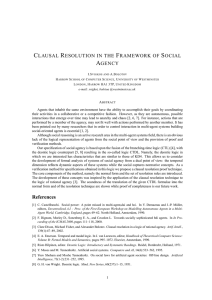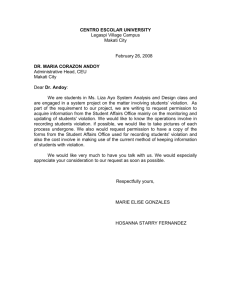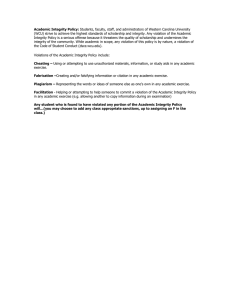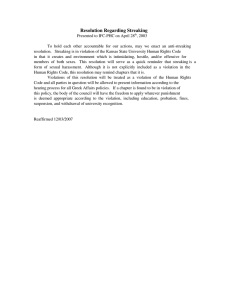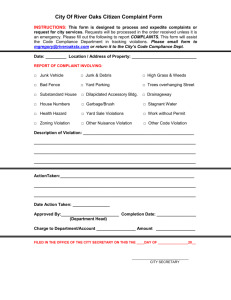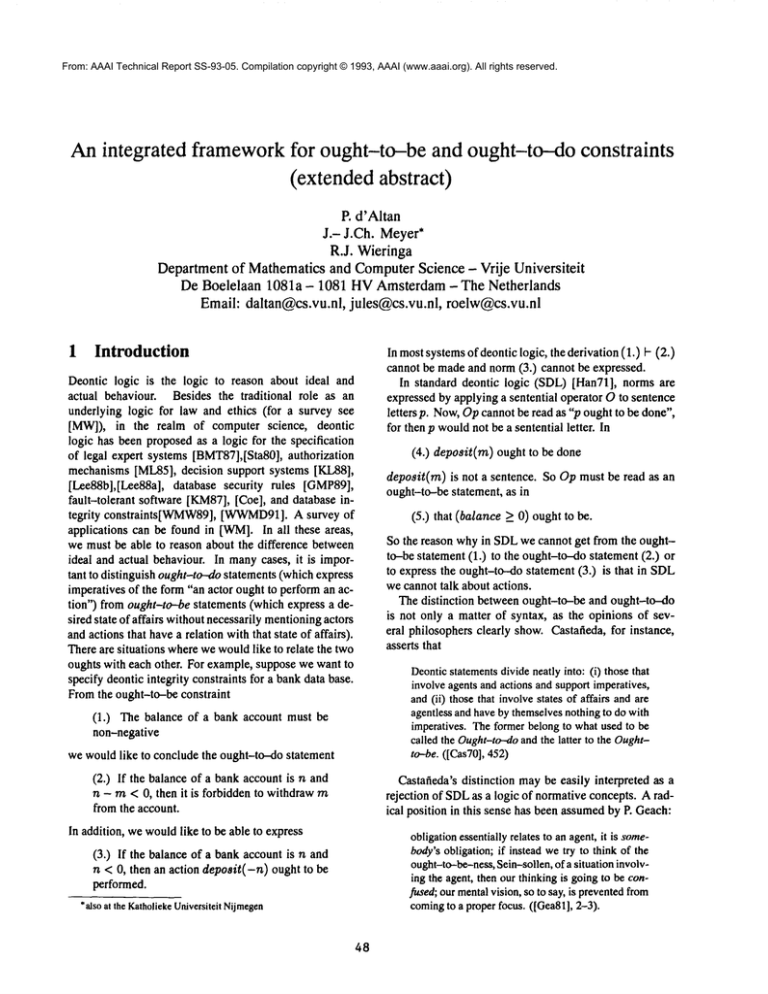
From: AAAI Technical Report SS-93-05. Compilation copyright © 1993, AAAI (www.aaai.org). All rights reserved.
Anintegrated framework
for ought-to-be and ought-to-do constraints
(extendedabstract)
P. d’Altan
J.- J.Ch. Meyer*
R.J. Wieringa
Department of Mathematics and Computer Science - Vrije Universiteit
De Boelelaan 1081a - 1081 HV Amsterdam - The Netherlands
Email: daltan@cs.vu.nl,
jules@cs.vu.nl,
roelw@cs.vu.nl
1
Introduction
Deontic logic is the logic to reason about ideal and
actual behaviour. Besides the traditional role as an
underlying logic for law and ethics (for a survey see
[MW]), in the realm of computer science, deontic
logic has been proposed as a logic for the specification
of legal expert systems [BMT87],[Sta80],authorization
mechanisms[ML85],decision support systems [Kd.,88],
[Lee88b],[Lee88a], database security rules [GMP89],
fault-tolerant software [KM87],[Coe], and database integrity constraints[WMW89], [WWMD91].
A survey of
applications can be found in [WM].In all these areas,
we must be able to reason about the difference between
ideal and actual behaviour. In manycases, it is important to distinguish ought-to--do statements (whichexpress
imperatives of the form "an actor ought to perform an action") from ought-to--be statements (whichexpress a desired state of affairs without necessarily mentioningactors
and actions that havea relation with that state of affairs).
There are situations wherewe wouldlike to relate the two
oughts with each other. For example, suppose we want to
specify deontic integrity constraints for a bank data base.
Fromthe ought-to-be constraint
(1.) The balance of a bank account must
non-negative
we wouldlike to conclude the ought-to--do statement
(2.) If the balance of a bank account is n and
n - m < 0, then it is forbidden to withdrawm
from the account.
In mostsystemsof deontic logic, the derivation (1.) I- (2.)
cannot be made and norm(3.) cannot be expressed.
In standard deontic logic (SDL) [Han71], norms are
expressed by applying a sentential operator O to sentence
letters p. Now,Opcannot be read as "p ought to be done",
for then p wouldnot be a sentential letter. In
(4.) deposit(m) ought to be done
deposit(m) is not a sentence. So Opmust be read as an
ought-to-be statement, as in
(5.) that (balance > 0) ought to be.
So the reason whyin SDLwe cannot get from the oughttry-be statement (1.) to the ought-to--do statement (2.)
to express the ought-to-do statement (3.) is that in SDL
we cannot talk about actions.
The distinction betweenought-ttr-be and ought-to--do
is not only a matter of syntax, as the opinions of several philosophers clearly show. Castafieda, for instance,
asserts that
Deonticstatementsdivide neatly into: (i) those that
involveagents and actions and supportimperatives,
and (ii) those that involvestates of affairs and are
agentless and haveby themselvesnothingto do with
imperatives. Theformerbelong to what used to be
called the Ought-to--doand the latter to the Oughtto--be. ([Cas70],452)
Castafieda’s distinction maybe easily interpreted as a
rejection of SDLas a logic of normative concepts. A radical position in this sense has been assumedby P. Geach:
In addition, we wouldlike to be able to express
obligationessentiallyrelates to an agent,it is somebody’sobligation; if instead wetry to think of the
ought-to--be-ness,
Sein-sollen,of a situation involving the agent, then our thinkingis goingto be confused; our mentalvision, so to say, is preventedfrom
comingto a properfocus. ([Gea8l], 2-3).
(3.) If the balance of a bank account is n and
n < 0, then an action deposit(-n) ought to be
performed.
*alsoat the Katholiek¢
Univetsit¢it
Nijmegen
48
Geachtries accordingly to showthat ought-to-be statements are to be understood as ought-to-do onest :
’Thereoughtto be a law against smokingin buses’
(if the speakeris really thinking)will meanthat the
predicable ’-- oughtto makea law against smoking
in buses’is true of somepersonor persons.([Gea81],
4)
Similar ideas seem to have been already defended by W.
2D. Ross and before him by A. Prichard
Other authors, e.g., yon Wright, defend a moremoderate
position, lnstead of eliminating one of the twoterms of the
question, as Geachdoes, they assign to the ought-to-be an
autonomoussphere of meaning: we quote from [vW63]
Thereis, however,a groupof normswhichare immediatelyconcemed,
not with action, but withthings
that oughtto or mayor mustnot be. German
writers
sometimesmakea distinction betweenTunsollenand
Seinsollen. [...] FollowingG.E.Moore,I shall call
normswhichare concernedwith being rather than
withdoing,idealrules. Idealrules are referredto, for
example,whenwesay that a manoughtto be generous, truthful, just, temperate,etc., andalso whenwe
say that a soldier in the armyshouldbe brave,hardy,
anddisciplined;a schoolmaster
patient withchildren,
firm andunderstanding;a watchman
alert, observant,
andresolute;andso forth. [... ] Idealrules are closely
connectedwith the conceptof goodness.[...] The
features whichideal rules require to be presentin
goodmembers
of a class or kind of human
beings can
be termedthe virtues characteristic of menof that
class or kind. ([vW63],13-14).
to use it for expressing more prosaic things like static
deontic constraints such as (1.), wherethe deontic operator
expresses an "ideal" necessity but no moralattitude at all
(i.e., wewill indeed consider a particular kind of alethic
modalities, those that satisfy axiomD).
But we also need to extend SDLto deal with dynamic
deontic contraints like (2.) and (3.), this will be done
using propositional dynamiclogic.
Wefirst briefly review Anderson’sreduction of ought
to be statements to alethic ones and successively Meyer’s
reduction of ought to do statements to dynamicones. In
the last sections we will showhowby makinguse of both
reductions it is possible to solve the expressivity problems
sketchedin the first part of this introduction.
Andersonreduction of ought-to-be
sentences to alethic modalones
2
The deontic system Andersonconsiders in [And67]is von
Wright’s system Mwithout the T-axiom(i.e., Op~ p), in
the classification of Lemmon
[Seg77] and Chellas [Che80]
it is called Dand KD,respectively.
Anderson’s reduction may be seen as a kind of Dawson’s modelling [Daw59]for SDLin which O-sentences
are interpreted by means of T-formulas of the form
D(--,p ~ V), where V is a propositional constant interpreted by Andersonrather freely as either expressing
someform of sanction or a bad thing or also as stating
that "things go wrong". Thus, Andersonreduction of Op
has to be read as "necessarily, --,p implies a sanction (that
things go wrong)". Vis subject to three conditions:
For certain aspects, VonWright’s conception has already been maintained since the beginning of this century by the phenomenologicalschool (Brentano, Husseri,
Meinong and Mally) and reached its highpoint with
Scheler and Hartmann, who grounded ought-to--do upon
ought-to-be (a conclusion opposite to Geach’sone). According to these authors, not only SDLwouldnot be a logic
of the ought-to--do but also it could not express oughtto-be statements adequately for reasoning about what is
good and bad. The main reason is that speaking of bad
and gooddoes not seem to require any notion of necessity
at all differently fromwhat is implicit assumptionin SDL.
This might better be used to reason about possible (moral
or not moral) worlds. Of course, this meansalso that SDL
is inadequate for representing moral norms.
However,this is no real drawbackfor our purposes.
For us, SDLis useful for describing desiderable states of
affairs devoid of any moral content. Weare indeed going
I Fora criticalappraisal
of Geach’s
paper
see[Gar86]
2Cfr.[Gar86],276n22.Thepaperof Prichardcanalsobe foundin
[SH70],
86--96.
49
1) O-~Vis assumed(or proved) valid
2) --,V cannot be proved valid
3) V cannot be proved valid
Viewedmodel-theoretically, models for the deontic
system are just a special kind of modelsfor modalsentences. The nature of these models can be shownin a
rather straightforwardway.Let .1_ represent a logical contradiction. In propositional calculus (PC) we can prove
that for everyp it holds true that
p--(~-~ ~).
In every normal modal system this involves also the
truth of
= n(.p .-, l).
As it should be apparent, we have here an analogonof An3.
derson’s reduction whereV is replaced by a contradiction
3Thisalsorepresentsthe classicalviewaboutnecessityaccording
to whichwhatis necessaryis by definitioncontraryto whatimplies
contradiction.
Intuitively, contradiction can be seen as a sort of logical
"things go wrong"in the sense that ifp is necessarily true
then assumingit false involvesa sort of logical breakdown.
The same piece of reasoning may howeverbe applied to
the deontic case: if the state of affairs p oughtto be, then
if it were not the case, somethingwouldgo deontically
wrong.In other words, "things go wrong"(deontically)
a sort of deontic contradiction. Of course, it is muchless
strong qua logical nature than an alethic one, since wecannot prove it to be a contradiction (condition 2 above).
logical contradiction is moreoverfalse in every accessible
possible world, so that
is derivable in every normalsystem. It is nowevident that
necessity operators maybe deontically interpreted only
whereV is false. That is, if wedefine Opas [](~p ---+ V),
then a sufficient condition for w ~ Dp =. Opis
Vw’(wRw’w’
This explains whywe cannot in general consider [] and 0
as representing the samenotion of necessity.
Wewill deviate from Anderson’sformulation at least in
one importantaspect. Wehave seen that he interprets V in
terms of sanction or in terms of an unspecified bad thing.
Wepropose a more specific reading in terms of "violation". Weread Opas "necessarily, -p implies violation
of the normative system to which Op belongs", where
with normative system we simply intend a set of deontic
constraints, thus not necessarily (or preferably not) moral
norms. There are principally two reasons that justify our
reading of V:
1. It avoids the counterintuitive readings of a few
derivations of SDL. These readings are counterintuitive whenV is interpretated as sanction (cfr.
[Cas60]). Consider, for example, [3(V --. V)
Pp - O(pA -,V). The former formula means in Anderson’s system"sanctions are forbidden" and this is
evidently counterintuitive. For the latter, consider
the following exampletaken from [Cas60], 46:
Let V,i.e. the sanctionmentioned
in the Penal
Code,be ’youwill be put in jail for 10 years’;
andp be ’youwill be put in jail for 9 years’.
Clearly,it is logically possibleto put youin
jail for 9, but not 10 years. Thus,it follows
logicallythat it is permittedto put youin jail
for 9 years -- withoutado!
3
Reduction of ought-to-do
tences to dynamicones
sen-
Inspired by Anderson’snot so satisfactory (wrt ought-to-do) reduction to alethic modallogic, and after analyzing
the reason whyit failed, Meyer[Mey881proposed another
reduction, in this case to propositional dynamiclogic. A
consequenceof the use of dynamiclogic is the distinction
betweenpropositions (assertions) and actions (practitions,
cf. [Cas8l]). Meyer’s reduction uses Anderson’s violation atomV to indicate that an action has occurred that
violates one of the deontic constraints.
(Propositional) DynamicLogic (PDL,cf. [Har84])
sists of the normalpropositional language, extendedwith
modal operator [a] for every action a in the language.
These actions are either atomic (primitive) or composed
by means of operators. An expression [ale is read as
"the performance(execution) of the action a leads necessarily to a state (possible world) in which¢ holds".
this approach, a is forbidden (_Pa), permitted (Pa), and
obligated (On) are reduced to dynamic expressions as
follows:
Definition 3.1
= b]v
Po= - Po(=
0a =
(1)
(2)
(3)
Here for the reduction of the obligation operator 0, we
employed the negation of an action 0, denoted ~, expressing refraining from the perfomanceof a. The concept of action negation is discussed in [Mey89],[DM90]
and [WM91].
The formal semantics is given by means of a Kripke
structure wherethere are accessibility relations Ra associated with each action 0. In particular, PDLis characterized by irrrefiexive frames of possible worlds.
Definition 3.2 A model M for PDLis given by M =
(p+(a), [O]R, [:=)
where p+(A)represents the powerset of sets of actions,
Wa set ofpossible worlds, [c~] R a function that associates
to action o andworldw, the set of possible worldsto which
the performanceof o leads, and ~ the usual truth-relation
between worlds and sentences.
The truth-definitions for dynamicformulas are as follows:
2. Our reading offers an almost tautological and therefore scarcely objectionable reading of deontic formulas: if I do not fulfil a norm,then I violate it, or ifp
is not the case, then the relevant constraint has been
violated.
50
Definition 3.3
w ~ [a]¢ iff
Vw’(w’ E [O]R(W) ~
Wt
b ~))
i.e., sentence [a]¢ /s true in w iff ¢ holds true in every
world accessible from w by performing o.
The approach of reducing standard deontic logic to dynamic logic has the advantage of allowing integration of
static deontic constraints (Seinsollcn or ought-to-be sentences) with dynamicdeontic constraints (Tunsollcn
ought-to-do sentences). This will be the subject of the
following section.
4
Axiomatization
The system we are going to assumeas basic is characterized as a mixedmodal-dynamiclogic with the following
axioms
Axiom 4.1
Specification 5.2
O(b _> 0)
(b =n ^m>0) -~ [w(m)](b
<,~ - m) (2)
(b = n ^ m>_O)~ [w(m)](b
>n
(3)
(b = n A m_> O) ---, [d(m)](b > n + rn)
(4)
(b= ,~ Am> 0)--, [d(m)](b
< ,~
(5)
Note that we interpret not-withdrawal (m) as a withdrawal of less than rn (including depositing any amount
of money).This is a choice that is straightforward in this
example. In general we mayconsider other choices.
Let n, m> 0. Wehave to show that (1) + (2) semantic_ally imply
Proposition 5.3
~(p--. q)-~(Dp
--,
K
[3p ---*p
T
~Dp ---* D~Dp
5
O--V
[a](p ~ q) --* ([a]p ---* [a]q)
(b =n An - m<o) --, ~(w(m))
Proof
(b=nAn-m<O)--,
--, [w(m)](b
< n - m)
D
from Specif. 5.2.2
AK
(b = n A,~ - m< 0) ~ [w(m)](b
(b = n A,~ - ,n <0) --, [w(m)b(b
> 0)
D(-~(b
>0)--, V)
Therules are, as usual, necessitation for both operators
(N and [N], respectively) and modusponens (MP).
5
(1)
from Specif. 5.2.1 and Def. 5.1 b
Fromought-to-be to ought-to-do
The integration requires no particular technical step besides the definition of modaland dynamicoughtin terms of
Andersonand Meyerreduction, respectively. For modal
fomulas we will adopt a SS-semanticsadapted in order to
4 and retain the standard semantics
cope with axiom<>~V
of PDLfor dynamic formulas.
Weconsider the formal counterpart of the examplepresented in the introduction.
Let b means "balance", w(rn) "withdraw at least
from the account", and d(m) "deposit at feast mon the
account", whereb is a variable, n and mconstants.
Wemake use of the following
(b =,~ An -~<o) --, [w(m)]v
wewill refer to this formulaas (6)
(b = ,~ A~ -m<0) ~ P(w(m))
from Def. 3.1.1
In addition, we can derive the constraint about undoing
the negative account balance
Proposition 5.4
(b = n An < 0) ~ O(d(-n))
Proof
Definition 5.1
Fp=o(p--, V)
(a)
op=D(-v--, v)
(b)
and of axiomsof arithmetic.
Wehavea specification consisting of the followingconstraints:
4See [Aqv88],107-113, for details.
51
(b=n A-n>o) --, [d(-,~)](b
< n+ (-n))
from Specif. 5.2.5
[](-(b>0) --, V)
from Specif. 5.2.1 and Def. 5.1 b
(b =n ^-n_>o)-~[d(-~)]V
Wemaynow wonder whether with negative balance it
is obligatory or permitted to deposit morethan not simply
-n. Let’s begin with permission.
Let m > -n. Does the following formula hold?
b = n ^ n < 0 P(d(m))
(7)
Perhaps somewhatsurprisingly it does not without the
addition of more information.
Wehave to make a few assumptions, one of which is
not plausible without notions that we will present in the
following section about refinement (cfr. As. 6.10 and As.
6.11).
Furthermore, we cannot derive the following
b = ^ < 0 [d(m)](b < n m)
This blocks the derivation of O(d(m)). reason is,
of course, that from b < n + mwe nowcannot infer that
b _< 0 and, hence, we cannot apply Specif. 5.2.1 in order
to conclude O(d(m)). This is as one may expect. But,
rather surprisingly, we cannot infer
(b = n A n < O) ~ --,O(d(m))
either. After the refinement of the following section, we
shall showhowthis can be repaired.
6
Refinement
The refinement concernsthe formalization of the violation
atom. The main idea is that of indexing atoms. In particular, we will consider two different form of indexing.
Thefirst one relates a normand the relative violation to a
certain piece of legislation wherethe normis considered.
The second one considers violation with relation to the
normthat has been violated.
6.1
since we knowexactly where the violation has arisen. So
that relating the violation to the relevant legal trespassing
seems moreadherent to the reality than not makinguse of
an all-purpose violation atom.
Note that under this rewriting of violation, for every norm(obligations and prohibitions) of type i,
have a permission of the same type. This depends
upon the validity in reduced SDLof the equivalence
t2(--,p ~ Vi) = --,O(-~p ^ -’,Vi). This implies that the
piece of legislation to which i refers not only have to
state what norms fall under ought-to-be and what under
ought-to-do, but also what is permitted (or compatible)
with these norms.
This is not the only shortcoming from which indexing
suffers. The real problemis exactly that both ought-to--do
and ought-to-be have to be contemplatedin the same, say,
paragraphof the code and possibly to be put in relation.
This device does not explain whythe same piece of legal
text can put "it ought to be that p" and "it ought to be
broughtabout that p" in relation, without maintainingthat
the text indeed refer to both ought to do and oughtto be,
and thus that either the lawgiver has issued two different
norms under the same paragraph or he has assumed the
existence of a criterion for relating them. But whether
the latter exists and howit worksis exactly what we are
interested in. That is in short whywemaynot be satisfied
with this kind of indexing.
Refinement
I
Wedivide the space of normsin classes the typical representant of which is i. Wesay that two normsare of the
sametype i if and only if the relative violations haveboth
the form Vi. ASalready pointed out, index i refers to a
piece of legislation, whichwe do not specify further, for
instance, a paragraphof a code of laws.
The reason for adopting such device is more of conceptual than technical character. Wecan indeed easily show
that derivation of Prop. 5.3 has not to be altered in order to
cope with the indexed violation. The justification of our
choice is hence to be sought elsewhere. In reduced SDL,
wespeak of violation in a very general way, that is, when
we speaking of non fulfilment of a normwe say that the
whole normative system to which the norm belongs has
been violated. This is so only by wayof approximation,
52
6.2
Refinement
II
Instead of relating violations to the normsof whichthey are
violation by mentioning the relevant piece of law where
the normis printed, we maychoosethe straightforward solution of associating the violation to its related norm.That
is, we propose to distinguish violation states according
to the cause of the violation, i.e., if a is obligatory(0o0,
then we say that refraining from performinga leads to a
violation of On. Werepresent this violation by the atom
VO,~ whereOais called a violation flag.
An important reason for adopting this device is that it
provides the possibility to undothe violation. Since we
wouldnot want to undoa violation caused by withdrawing
too much moneyfrom an account by, say, returning an
overduebookto the library, werefine Vso that it indicates
the cause of the violation and consequentely the way in
whichthe violation is to be undone.
Using flagged violations, applying Meyerreduction to
Prop. 5.3 wouldhave yielded
(b = n A n - m < O) --* [w(m)]Vl,(w(m)) (6’)
Now,(6’) is different from(6) since in the latter the
lation refers to Specification5.2.1:
(b = n ^ n - m < O) ~ [w(m)]Vo(b>_o) (6)
In order to derive Prop. 5.3 from specifications (1)
(2), we haveto relate the twoviolation in a plausible way.
Firstly, we adopt Segerberg’s/~-operator (cf. [Seg89])
to express consequencesof actions. Wesimply recall the
intuitive meaningof this operator:
6p = "a choicefromall actions a that bring it aboutthat
p (makep true)".
Secondly, we introduce the notion of involvement betwin actions.
Definition6.1 Let a and~ be actions, ~b a state of affairs,
we define "a involves ~" (a ~) as follows:
Fromdefinition 6.1, it follows that
Proposition 6.2
ProofFromDef. 6.1 it follows that [B]~b~ [a]~b, which
by substitution (V for @)yields Prop. 6.2.
and also that
Proposition 6.3
[a]p a >@
Proof By definition r, belongs to [SP~R, and hence
laiR c [/3]R , which yields the theorem.
¯
If we consider unflagged violation, we can easily show
that semanticallythe followingare validities:
Proposition 6.4
[p]p
Proof Every performance of @leads to a world where p
holds, i.e., Vw’(w’ E [@~R(W)=~ w’ ~ p), hence
the thesis.
¯
Proposition 6.5
Proof In every world accessible by performing 6p both p
and p D V holds, hence V and P(~fp).
If we assumeflagged violation Prop. 6.5 maybe proved
only by defining dependencerelations amongflags. The
reason is that we can easily provethat
Fp ~- [6p]V#~
Of course, if we have a constraint of the kind
vVrp ~ Vps
(9)
formula (*) wouldbe easily provedby applying necessitation to (9) and consequently modusponens to axiom
(i.e., to [t~p](VFp""* V#6p)"* ([6p]V$,p--~ [~p]V$,6p)).
Now,formula(9) has no clear interpretation in our system,
since V$,pshould represent a violation of the normative
system to which Fp belongs (or, considering the simpler
formalization proposed by Meyerand Wieringa in, e.g.,
[WM],the system in which p is normed) and (9) would
consequentely mean that wheneverthe normative system
to whichFp belongs has been violated, then so it has also
the system to which ~p belongs. Wehave of course to
explain how the two systems may be one and the same
system.
The problem, however, is that we may not assume relations betweenviolations as more primitive than those
normsto which the violations refer. That in our first,
simpler systemwe could avoid this difficulty, showsonly
that we had to be careful in assumingthe existence of
essential logical relations betweenobjects (in this case
between"ought-tt>--do" and "ought-to-be") but not that
these relations are detectable only at an appropriate level
of abstraction, with that implyingthat the flagged system
is not abstract enough.
The most valuable solution is according to us that of
taking Proposition 6.5 as an additional assumption. That
is to say, acceptingthat philosophicalposition outlined at
the end of section 1, where ought-to-do was seen as a
meansin order to realize the ideality espressed by oughttit-be.
In a certain sense, the fact that Proposition 6.5 cannot
be derived in the refined systemis not surprising. Section
1 should have already shownthat any decision about the
relations between ought-to--do and ought-to-be cannot
be simply taken by logic. Of course, the derivability of
Proposition 6.5 wouldhavebeen a refutation of all that.
Propositions6.4 and 6.3 are still derivablein the flagged
system, since there no flagged violation needs to occur in
their proof.
The importance of having something like Proposition
6.5 is, of course, that it allows to bring it about the
desidered derivation (i.e., from Specif. 5.2.1, to derive
the statement(2.) of section 1).
Assumption 6.6
Fp P( p)
Definitions 5.1 and 3.1.1 take nowthe form
(6.5’)
Definition 6.7
but not that
[6p]V~.p
~ [6p]Vps
p
(*)
Fp = C3(p-~VFp)
53
(a)
Vop)
Op= n(=
(b)
(c)
Definition 6.9 Let xi , i E N, represents a generic norm
(obligation or prohibition) of a given normativesystem
Wedefine the following
To themwe add the standard definition
Definition 6.8
Op = F-p
Webegin nowto perform the derivation of Prop. 5.3,
though, as wewill see, this will showitself still impossible.
By logic, we may indeed prove that F(VFv) (cfr. remark at the end of section 2) but not that F(V~) is a
theorcmof the calculus. The lattcr result is exactly what
we need in order to apply As. 6.6 and Def. 6.9 enables us
to deriveit.
Since in SDLthe following equivalence holds
(b = n A n - m < 0) ~ [w(m)]--,(b
F(b V q) - Fb A
as before
it is straightforwardto concludethat
F-,(b >_O)
F(VFv) -’~ F(VF-,(b>_O))
from Specif. 5.2.1 and Def. 6.8)
o(-,(b ~ O) VF-,(b>o))
and hence, being able to apply As. 6.6 (rememberF(V~,v)
is a theoremof the calculus), we obtain
from Def 6.7 a
(b = n A n - m < O) ~
~k~(~(VF--,(b ~ 0)))
and eventually by MPand PC
[w(m)]VF.~(b~O)
(b = n A n - m < 0) ~ (w(m) ~6(VF-~(b>_O)))
(b -- n A n - m< 0) ---* b~(w(m))
from Prop. 6.3
(b = n A n- m < O)
~ (#(6(VF..(b~o)))
~( w(m)))
from Prop. 6.2
To get the derived result we need
~(~(VF’.(b~_O)))
however, this step cannot be performed by applying
(As.6.6).
A possible solution to this impasse is considering the
relation betweenthe violation of a particular normand
what we might call a generic violation of the normative
system to which that particular norm belongs. The idea
is that atom V=, where x represents an arbitrary norm,
does not only express the violation of a normbelonging
to a given normative system S but, more generally, also
a violation within that very system. Wecan express that
by saying that violation of a normof S is a sufficient
condition for the violation of S itself. Formally, we may
represent this fact as follows
(8)
--, Vvv
wherewe define Vrv as the disjunction of all the violations
that can take place within a given normativesystem(here,
FVmeans approximatively that it is forbidden to break
normsor that violating normsis forbidden).
54
Wecan now go back to the problem sketched at the
end of the previous section, i.e., whetherformula (7)
derivable in our system. Weobserved that without more
information it could not be derived.
If we consider a generic norm, say, Op, we see that
an intuitive necessary and sufficient condition for Vopto
holdis exactlythat --,p is the case.
Assumption 6.10
Vow)
Furthermore, if we assumethat we can always deposit,
we have to admit a further assumption.
Assumption 6.11
(d(m))T
Before proving formula (7), we need also to give a more
exact definition of permissionthan not that given as Def.
3.1.2.
Definition 6.12
Nowwe can prove formula (7).
Proposition 6.13
b = n ^ n < 0 -~ P(d(m))
(7)
Proof
D(b>0 ,-. -~VO(b>_o))
from As. 6.10 and Specif. 5.2.1
b =,~ ^ n< 0 -, [d(m)](b
> O)
from Specif. 5.2.4
b = n ^ n < 0 --* [d(m)]-~Vo(b>O)
them. Wehave seen that by increasing the expressive
power of the language by flagging violation atoms, we
haveto state relations connectingthe violation of static
constraints with that of dynamic ones. In the solution
we have presented, we have chosen to relate ought-tobe to ought-to-do considered in its broadest sense by an
assumption (As. 6.6). Westill have to investigate how
this assumptioncan be fit into our semantic framework.
Current research includes also a characterization of
negated actions in the perspective of an application of
involvementalso to obligations and a study of the logical
properties of the systemsketched above (consistency and
completeness).
b = n A n < 0 --* (d(rn))-.Vo(b>_O)
from As. 6.11
References
[And67]
A.R. Anderson.The formal analysis of normative systems. In N. Rescher, editor, The
Logic of Decision and Action, pages 147213. University of Pittsburgh Press, 1967.
[hqv88]
Lennart /~qvist. Introduction to deontic
logic and the theory of normative systems.
Bibliopolis, Napoli, 1987[1988].
[BMT87]
C. Biagioli, P. Mariani, and D. Tiscornia. ESPLEX:A rule and conceptual based
modelfor representing statutes. In The First
International Conferenceon Artificial Intelligence andLaw, pages 240-251. ACM,
May1987.
[Cas60]
Weknowthat [d(m)](b < n + m) (with n + m positive)
holds. However,to derive (10), we need to knowwhether
positive values of b can indeed be obtained. For this
purpose we have to refine our specification by adding the
following
Hector-Neri Castafieda. Obligation and
modallogic. Logiqueet Analyse, 3:40--48,
1960.
[Cas70]
Hector-Neri Castafieda. On the semantics
of the ought-to--do. Synthese, 21:449--468,
1970.
Specification 6.15
[cas81]
Hector-Neri Castafieda. The paradoxes of
deontic logic: the simplest solution to all of
them in one fell swoop. In Risto Hilpinen,
editor, NewStudies in Deontic Logic, pages
37-85. D. Reidel, Dordrecht - Boston London, 1981.
[Che80]
Brian F. Chellas. ModalLogic. An Introduction. CambridgeUniversity Press, Cambridge, 1980.
[Coe]
J. Coenen. Top-downdevelopment of layered fault-tolerant systems and its problems
---a deontic perspective. In J.-J.Ch. Meyer
and R.J. Wieringa, editors, Deontic Logic
Remark6.14 The fact that we have to assume extra conditions for deriving (7) should not be really surprising,
think, e.g., of a situation where[2V wouldhold, we would
have as a consequencethat in that situation not anything
would be permitted/
Weconcludewith a few annotations about the non derivability of formula
(b =n ^ n<_O)-~-~O(d(m))
already consideredat the end of section 5.
In order to prove it we should be able to prove the
following (simply apply As. 6.10)
(b=n^n< O) --* (d(m))(bZ
O)
(10)
b = n A rn > 0 ~ (d(rn))(b = k), for > n (1
b = n A rn >_ 0 --* (d(rn))(b = k), for all (2
7
Conclusion
Wehave shown that the distinction between ought-todo and ought-to--be is relevant for at least somekinds of
systemspecification and that, maintaininga certain degree
of generality, it is possible to express both kinds of norms
in one systemwithout reducing one of themto the other or
even assumingthe existence of specific relations between
55
in Computer Science: Normative System
Specification. Wiley. to be published.
[Daw59]
[DM90I
[Gar86]
E. E. Dawson.A model for deontic logic.
Analysis, 19:73-78, 1959.
EP.M. Dignumand J.-J.Ch. Meyer. Negations of transactions and their use in the
specification of dynamic and deontic integrity constraints. In M.Z. Kwiatkowska,
M.W.Shields, and R.M. Thomas,editors,
Semantics for Concurrency, pages 61-80.
Springer, 1990.
J. L. A. Garcfa. The tunsollen, the
seinsollen, and the soseinsollen. American Philosophical Quarterly, 23:267-276,
1986.
[Gea81]
Peter Geach. Whateverhappenedto deontic
logic? Philosophia, 11:1-12, 1981.
[GMP891
J. Glasgow, G. MacEwen,and P. Panangaden. Security by permissionin databases.
In C.E. Landwehr, editor, Database Security II: Status and Prospects, pages 197205. North-Holland, 1989. Results of the
IFIP WG11.3 Workshop on Database Security (October 1988), Kingston, Ontario,
Canada.
[Han71]
Bengt Hansson. An analysis of some deontic logics. In Risto Hilpinen,editor, Deontic
Logic: Introductory and Systematic Readings, pages 121-147. D.Reidel, Dordrecht,
1971.
[Har84]
D. Harel. Dynamic logic. In D.M. Gabbay and E Guenthner, editors, Handbookof
Philosophical Logic I1, pages 497--604. D.
Reidel, 1984.
[KL88]
S.O. Kimbroughand R.M. Lee. Logic modeling: A tool for management
science. Decision Support Systems, 4:3-16, 1988.
[KM87]
S. Khosla and T.S.E. Maibaum.The prescription and description of state based systems. In B. Banieqbal, H. Barringer, and
A. Pnueli, editors, TemporalLogic in Specification, pages 243--294. Springer, 1987.
Lecture Notes in ComputerScience 398.
[Lee88a]
R.M. Lee. Bureaucracies as deontic systems. ACMTransactions on Office Information Systems, 6:87-108, 1988.
56
[Lee88b]
R.M.Lee. A logic modelfor electronic contracting. Decision Support Systems, 4:2744, 1988.
[Mey88]
J.-J.Ch. Meyer.A different approach to deontic logic: Deonticlogic viewedas a variant of dynamiclogic. Notre DameJournal
o[ FormalLogic, 29:109--136, 1988.
[Mey89]
J.-J.Ch. Meyer. Using programming concepts in deontic reasoning. In R. Bartsch,
J.F.A.K.
van Benthem, and P. van
EmdeBoas, editors, Semantics and Contextual Expression, pages 117-145. FORIS
publications, Dordrecht/Riverton, 1989.
[ML85]
N.H. Minsky and A.D. Lockman. Ensuring
integrity by addingobligations to priviliges.
In 8th IEEE International Conference on
Software Engineering, pages 92-102, 1985.
[MW]
J.-J.Ch. Meyerand R.J. Wieringa. Deontic logic: A concise overview. In J.-J.Ch.
Meyerand R.J. wieringa, editors, Deontic
Logic in ComputerScience: NormativeSystem Specification. Wiley. to be published.
[Seg77]
Krister Segerberg,editor. An introduction to
modal logic by E.J. Lemmon(in coll. with
D. Scott), volume 11 of APQMonograph
Series. Basil Blackwell, Oxford, 1977.
[Seg89]
Krister Segerberg. Bringing it about. Journal of Philosophical Logic, 18:327-347,
1989.
[SH70]
Wilfrid Sellars and John Hospers, editors.
Readingsin Ethical Theory. Prentice-Hall,
Inc., Englewood
Cliffs, N J, 1970. 2nd ed.
[Sta80]
R. Stamper. LEGOL: Modelling legal
rules by computer. In B. Niblett, editor,
Com[puterScience and Law, pages 45-71.
CambridgeUniversity Press, 1980.
[vW63]
Georg Henrik von Wright. Norm and Action. Routledge and KeganPaul, London,
1963.
[WM]
R.J. wieringa and J.-J.Ch. Meyer. Applications of deontic logic in computerscience:
A concise overview. In J.-J.Ch. Meyer
and R.J. wieringa, editors, Deontic Logic
in Computer Science: Normative System
Specification. Wiley. to be published.
[WM91]
R.J. Wieringa and J.-J.Ch. Meyer. Actors,
actions, and initiative in normative system specification. Technical Report IR-257,
Faculty of Mathematics and ComputerScience, Vrije Universiteit, Amsterdam,October 1991. To be published, Annals of Mathematics andArtificial Intelligence.
[WMW89]
R.J. Wieringa, J.-J. Ch. Meyer, and
H. Weigand. Specifying dynamic and deontic integrity constraints. Data and Knowledge Engineering, 4:157-189, 1989.
[WWMD91] R.J. Wieringa,H. Weigand,J.-J. Ch. Meyer,
and E Dignum.The inheritance of dynamic
and deontic integrity constraints. Annals
of Mathematicsand Artificial Intelligence,
3:393-428, 1991.
57

